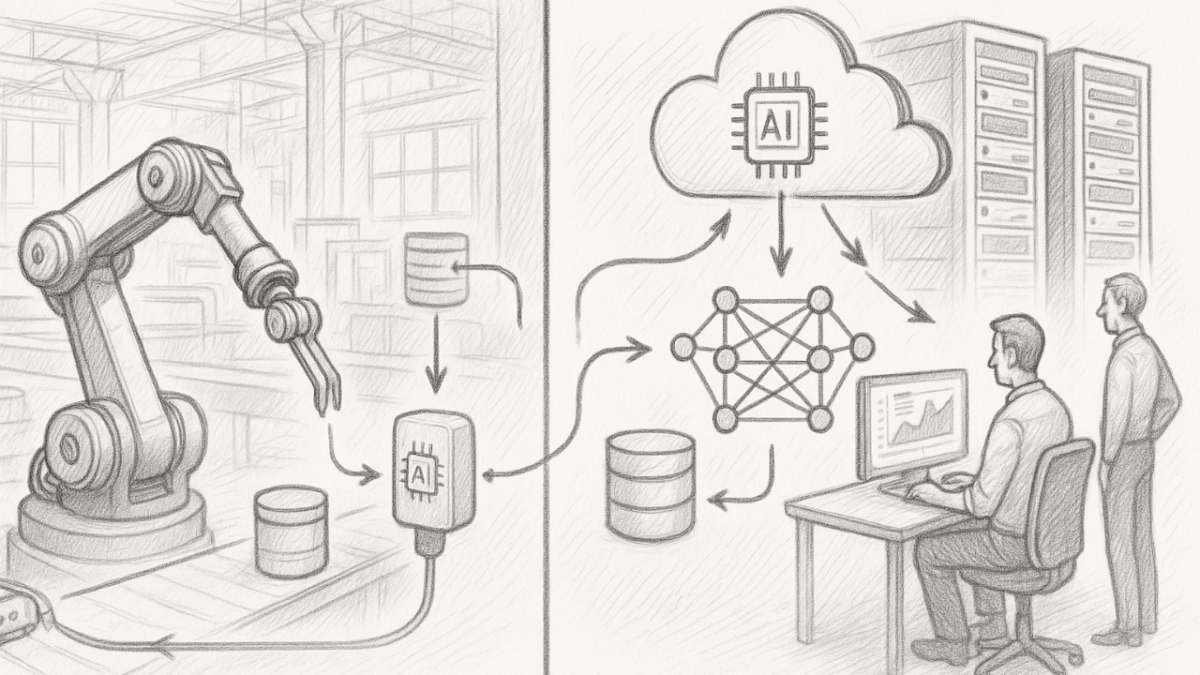Edge AI vs. Cloud AI: What’s Better for Enterprise Workloads?
Table of Contents
Introduction
Artificial Intelligence (AI) has become the backbone of digital transformation, and enterprises today are deploying AI-powered solutions across everything from customer service to predictive maintenance. But as AI adoption scales, a new question emerges: Where should AI processing happen—on the edge or in the cloud?
Enter the debate of Edge AI vs. Cloud AI.
Both offer unique advantages depending on the use case, infrastructure, and latency sensitivity. This article breaks down the key differences, advantages, and when enterprises should choose one over the other—or both.
What Is Edge AI?
Edge AI refers to running AI algorithms directly on local hardware or edge devices (like IoT sensors, mobile devices, or local servers), without needing to send data to the cloud. Think of AI running on a factory robot, a smart camera, or an autonomous vehicle.
Key Features:
- Real-time processing
- Minimal latency
- Operates with limited or no internet connectivity
What Is Cloud AI?
Cloud AI is the delivery of AI processing and models via cloud infrastructure. This typically involves sending data to centralized cloud platforms like AWS, Google Cloud, or Azure, where powerful compute resources analyze and respond to that data.
Key Features:
- Centralized data storage
- Scalable processing power
- Ideal for batch processing and big data analytics
Side-by-Side Comparison
| Feature | Edge AI | Cloud AI |
|---|---|---|
| Latency | Ultra-low (real-time) | Higher (depends on network) |
| Connectivity Required | Minimal or none | High |
| Data Privacy | More control (local data) | Depends on cloud provider |
| Scalability | Limited to hardware | Virtually unlimited |
| Processing Power | Device-dependent | High-performance computing |
| Ideal Use Cases | Real-time, mission-critical apps | Big data, deep learning, analytics |
Use Cases: Edge AI in Action
- Manufacturing & Industry 4.0: In smart factories, Edge AI powers predictive maintenance by analyzing machine behavior on-site. This avoids downtime by identifying anomalies in real time—without needing cloud connectivity.
- Autonomous Vehicles: Self-driving systems can’t afford cloud latency. Edge AI helps vehicles make split-second decisions based on local sensor data.
- Retail & Surveillance: Edge-enabled smart cameras can detect theft, foot traffic, or shelf stock changes instantly—without relying on cloud bandwidth.
Use Cases: Where Cloud AI Shines
- Enterprise Analytics: Cloud AI excels in aggregating massive datasets for long-term analysis. CRM platforms, e-commerce sites, and fintech dashboards use cloud AI to predict customer behavior or detect fraud.
- Natural Language Processing (NLP): Virtual assistants, translation tools, and AI-driven customer service bots rely on complex language models like GPT—best run in the cloud.
- AI Model Training: Training large neural networks requires massive computing power—making cloud GPU clusters the preferred option for AI developers.
Security & Compliance Considerations
- Edge AI provides better data sovereignty, especially useful in regulated industries like healthcare and finance.
- Cloud AI must comply with regulations like GDPR, HIPAA, and CCPA, especially when transferring personal data across borders.
In sensitive environments, Edge AI helps mitigate risks by processing and storing data locally.
Hybrid AI: The Best of Both Worlds?
Increasingly, enterprises are adopting a hybrid AI architecture—processing urgent data on the edge while syncing with the cloud for long-term storage and model updates.
Example: A drone captures images (Edge AI) and sends them periodically to the cloud for training improvement and analytics.
This allows businesses to balance latency, cost, and scalability without compromising on performance.
Cost Considerations
- Edge AI has higher initial hardware investment but lower ongoing bandwidth costs.
- Cloud AI offers pay-as-you-go pricing but can become expensive at scale if large volumes of data are constantly transferred.
Enterprises must assess TCO (Total Cost of Ownership) depending on data volume, processing needs, and uptime requirements.
When to Choose Edge AI
Go with Edge AI if:
- You need real-time decision-making
- You’re operating in low/no connectivity areas
- Data privacy is a top priority
- The workload is predictable and local
When to Choose Cloud AI
Choose Cloud AI if:
- You need powerful AI model training and analytics
- Your workloads involve large datasets
- You need to scale AI across multiple locations fast
- You’re integrating with SaaS or cloud-native apps
Industry Insight
According to McKinsey, up to 75% of enterprise-generated data will be created and processed outside traditional data centers or cloud by 2025—making Edge AI a rapidly growing frontier. However, cloud remains essential for deep learning, centralized orchestration, and massive-scale processing.
Final Thoughts
There’s no one-size-fits-all solution when it comes to Edge AI vs. Cloud AI. Instead, enterprises must weigh latency, scalability, privacy, and cost to decide the right fit for each workload.
The future of AI is distributed—and your strategy should be too.
Call to Action
Want help deciding whether Edge AI, Cloud AI, or a hybrid model is right for your enterprise?
👉 Reach out to our team for a free consultation or explore our latest resources on enterprise AI strategy.
You May Also Like: Metaverse in Automobiles: Driving the Future of Mobility





